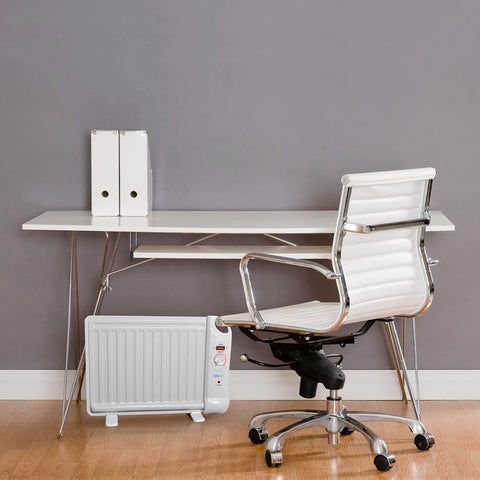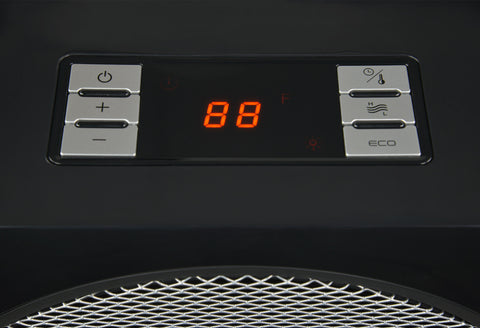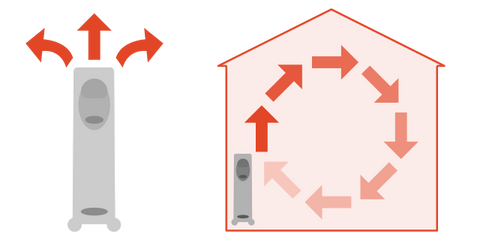What Type of Heater is Best for Me?
Winter is coming, the air is starting to hold a bit of chill, and it’s time to think about how you’ll stay warm through the cold weather. If you’ve been browsing through various buying guides, you know there are tons of choices when it comes to space heaters. We’d like to help you with picking exactly the right one. For starters, we’ll list the factors you’ll need to consider when shopping for a portable heater. After that, we’ll talk about how the different kinds of heaters work, and which ones are best for each room in your home.
Factors to Consider When Choosing a Space Heater
Room size: Many heaters are rated according to the square footage they can heat up. You also need to consider ceiling height, because a high-ceilinged room can be harder to heat.
Quality of insulation
Temperature Rise: This is the difference between your preferred room temperature and the outdoor air temperature.
Appearance (You’ll want something that doesn’t clash with your decor)
Noise level
Energy efficiency
Portability vs. permanently mounted
Location of your electrical outlets or gas lines
Need for venting: Gas heaters should be vented, or you run the risk of releasing carbon monoxide into your home.
Safety features - especially if you have pets or children. These include an automatic shutoff if the heater tips over or gets too hot.
Features: remote control, automatic thermostats and adjustable heat settings
Air quality: Do you need your heater to include a dust filter?
Kinds of Heat
One of the first things to understand, when you’re looking through heater buying guides, is that there are different kinds of heat. We don’t mean different fuels, such as electricity or gas or wood. The transfer of heat from a hotter material, like a heater or a fire, to a cooler material, like your body or a roomful of cold air, can happen in three ways: Conduction, convection, and radiation.
Matching Your Heater to a Specific Area of Your Home
Are you looking for a portable space heater for a particular room? Let’s talk about how to select the right heater for each area in your home.
Living room
When you think about which heater types are best for your living room, it’s helpful to consider size. You don’t want to use more electricity than you really need. If your living room is smaller than 250 square feet (equivalent to about 15 by 16 feet) then you can easily heat it with a small heater.
Living room heaters need to be effective at warming the space, but they also need to be attractive. You’ve put a lot of thought into your decor, so you don’t want a big, conspicuous heater that interferes with how your room looks. The NewAir QuietHeat 15 portable ceramic heater is a good choice for living rooms, because of its sleek design. This heater comes in three different colors, to match your room decor. Another great alternative for your living room is a baseboard heater like the NewAir AH 600. With its low profile, this portable electric heater not only looks ultramodern, but it also is very safe because it can’t be tipped over.

Bedroom
In your bedroom, the key factors for a good heater may include noise level and remote control or timer. When you get into bed, you don’t want a heater with such a loud fan that it keeps you awake. Oil-filled space heaters are great when it comes to noise level, because they have no whirring fan or moving parts. Some fan heaters, like the NewAir ceramic heater, also operate very quietly while heating the air of the room.
Have you ever turned up the heat in a chilly bedroom, and then climbed into bed, only to wake up hours later, feeling overwhelmingly hot? A timer or automated thermostat is a key feature for any bedroom heater, because you want to be able to fall asleep, confident that the room will stay at the temperature you choose.

Bathroom
In a bathroom, you often need a short-term source of heat. It feels good to get out of the shower into a warm room, so a small space heater that delivers warmth quickly is very welcome. Most of the time, the bathroom is not in use, and you may not need to keep it very warm. Factors that you may want to consider for a bathroom heater include a small profile, so that it can be pushed out of the walking area or stored in a cupboard when it’s not needed. Floor area is at a premium in bathrooms, so you want something that doesn’t take up a lot of real estate. A baseboard heater or a small personal heater can be ideal for bathroom use.
Office
Do you get chilly at work? Women are especially vulnerable to getting cold at work, because they feel cold sooner than men. Office buildings can also feel chilly because the ventilation systems create drafts, and often there are not enough windows to bring warming sunlight in. Having a small, energy-efficient personal heater under your desk can make a huge difference in productivity -- but if you bring one from home, you have to make sure it doesn’t use up too much energy or run a safety risk from operating near furniture. The NewAir AH-400 Energy Efficient personal space heater is an ideal solution. The slim profile of this small oil-filled heater allows it to fit anywhere, and be unobtrusive.

Garage
Garages are often the cold spots in the house. They may be entirely uninsulated, or even have openings or gaps where air leaks in from outdoors. Nevertheless, if you use your garage as a workshop space, you want to be able to heat it up. Garage heaters often use 240-Volt electrical outlets, so that they can deliver the heating power that a garage or worksite might need. These heaters make full use of both convection and radiant heating, with built-in fans as well as electric heating elements. You can get a portable heater for your garage that you can unplug and move around, or you can get one that will be hardwired into position.
The hardwired garage heaters are wall-mountable, or you can even attach them to the ceiling in order to have them entirely out of the way. The wall heaters come with a bracket that allows you to turn and tilt them so that their heat output is directed exactly where you need.
Apartments
Too often, renters encounter expensive, outdated sources of heat, because the landlord doesn’t have to pay the heating bills. Portable heaters are the ideal heating solution for you, to supplement whatever heat source comes with your rental unit. Matching the size of your space heater to the square footage of your apartment can often save you money on utility bills. Alternatively, you may just consider using a personal heater and keeping your apartment thermostat turned down low.
Personal Heaters
If you just need a heater close to where you sit, heating your body, then you don’t have to worry about calculating BTUs or adding up the square footage of a room. Personal heaters are created for spot heating, and their main benefit may be that they have a low profile and can fit easily underneath a desk. The NewAir AH-400 Oil-Filled Personal Heater is a great choice when you just need to stay warm where you’re sitting. It heats up quickly, and operates silently. Moreover, the heated oil inside the panel continues to warm you even after the heater is turned off, so it keeps your heating costs low.
Safety Features
Your children and pets rely on you to protect them from hazards. If you leave the room, you don’t want to worry about the fact that a child or a pet might be alone with the heater. Obviously, the most important safety issue to consider with portable heaters is whether anyone could accidentally get burned or start a fire. An inexpensive electric space heater that you buy off the shelf from your local drug or discount store may have a hazardously hot electric element. High quality portable heaters will automatically shut off if they tip over or get too hot.

Households with children or pets should consider ceramic or baseboard heaters, because a tightly woven mesh grill protects them from coming in contact with hot elements. When you’re planning the placement of a heater, think about whether there’s any risk that your pet might chew through the cord. Could anyone trip on a cord? It’s never a good idea to place a heater on top of a table, due to the risk that a human being or animal could accidentally cause it to fall down.
Which Type of Heater is Cheapest to Run?
In order to answer this question, we need to cover a little bit of information about how heating capacity is measured.
BTUs: The Universal Heat Unit
BTUs, or British Thermal Units, are a measure of heat. Technically, one btu is the amount of heat needed to raise the temperature of one pound of water by one degree Fahrenheit. It’s approximately the amount of heat produced by burning one single wooden kitchen match. The capacity of heaters is often measured in btus, because this unit has the advantage of applying to all types of fuel: It allows you to compare the heating capacity of electric heaters with those that consume propane, natural gas, or kerosene. (You’ll also see air conditioners rated by btu, and in those cases it’s a measurement of how much heat the air conditioner can remove from the air.)
Converting Watts to BTUs per Hour
If you’re looking at the specifications of an electric heater, and you only see its capacity listed in watts, you can easily convert watts to btus. One watt is equal to 3.41 btus per hour. So for a 1500-watt electric heater, you just multiply 1500 times 3.41, and you’ll get 5115 btus per hour.
Converting BTUs to Watts
Similarly, if you’re looking at a gas heater, you may want to know how its heating capacity compares with the wattage of electric heaters. One btu per hour is equal to 0.293 watts. For a gas heater with a heating capacity at 20,000 btus per hour, you would multiply 20,000 times 0.293, to get a result of 5860 watts. If you want the measurement in kilowatts, you just move the decimal point three places to the left -- so 5860 watts is the same as 5.86 kilowatts. To know how many kilowatt hours (kwh) your heater uses, multiply kilowatts by the number of hours that your heater is running. For example, if you run a 5 kilowatt heater for 2 hours, you will use 10 kwh.
How Many BTUs or Watts Do You Need?
There’s no simple answer to this question, because obviously the amount of heat you need depends on more than just the square footage of your space. While heater manufacturers may estimate the number of square feet that their products will heat, that figure is obviously affected by several things:
Cubic volume: How high is the ceiling? When you heat a room, the heat flows upwards first, and if you have high ceilings it will take longer for the air to feel warm down where you’re sitting or standing.
Insulation: Are you in a newly-built apartment with double-paned windows and high-quality insulation? Or are you looking to heat a leaky wood-frame house or uninsulated garage?
Climate: It takes less energy to heat a home in California than one in Minnesota.
Preferred Temperature: Do you just need to keep your collection of paints and finishes in the garage from freezing, or are you seeking to heat a home space to a steady 72 degrees?
Other factors
Minor conditions that affect the quantity of heat you need include the following:
1.Ceiling fan: You can take advantage of the warm air that’s hovering up by your ceiling, if you have a fan that will send it down to floor level.
2. Number of people: Body heat can actually add to a room’s comfort level; if you’re thinking of heating a small area where several people will be spending time, you may find that you need less heat.
3.Roof color: Buildings with dark roofs absorb more of the sun’s rays, making them warmer than those with light roofs.
4.Passive solar heat: South-facing windows can add warmth through solar radiation, greatly reducing the amount of heating needed.
Shopping for the right space heater can feel confusing, because there are so many brands and options. You’ll see brands online like DeLonghi and Pelonis, and high tech electric fireplaces that you can hang on your wall like a painting. Step into your local discount or home supply store, and you’ll find shelves full of inexpensive space heaters that may or may not include crucial safety features. NewAir sorts through all the factors that you need to consider, and offers you the safest and most efficient choices for all your heating needs.
Browse Portable Space Heaters






0 comments